Eyelid lift – (blepharoplasty)
Eyelid surgery (technically called blepharoplasty) is a procedure to remove fat--usually along with excess skin and muscle from the upper and lower eyelids. Eyelid surgery can correct drooping upper lids and puffy bags below your eyes – features that make you look older and more tired than you feel, and may even interfere with your vision. However, it won’t remove crow's feet or other wrinkles, eliminate dark circles under your eyes, or lift sagging eyebrows.
The Best Candidates for Eyelid Surgery
The best candidates for eyelid surgery are men and women who are physically healthy, psychologically stable, and realistic in their expectations. Most are 35 or older, but if droopy, baggy eyelids run in your family, you may decide to have eyelid surgery at a younger age.
A few medical conditions make blepharoplasty more risky. They include thyroid problems such as hypothyroidism and Graves' disease, dry eye or lack of sufficient tears, high blood pressure or other circulatory disorders, cardiovascular disease, and diabetes. A detached retina or glaucoma is also reason for caution; check with your ophthalmologist before you have surgery.
All Surgery Carries Some Uncertainty and Risk
When eyelid surgery is performed by a qualified plastic surgeon, complications are infrequent and usually minor. Nevertheless, there is always a possibility of complications, including infection or a reaction to the anesthesia. You can reduce your risks by closely following your surgeon's instructions both before and after surgery.
The minor complications that occasionally follow blepharoplasty include double or blurred vision for a few days; temporary swelling at the corner of the eyelids; and a slight asymmetry in healing or scarring. Tiny whiteheads may appear after your stitches are taken out; your surgeon can remove them easily with a very fine needle.
Planning Your Surgery
The initial consultation with your surgeon is very important. The surgeon will need your complete medical history, so check your own records ahead of time and be ready to provide this information. Be sure to inform your surgeon if you have any allergies; if you’re taking any vitamins, medications (prescription or over-the-counter), or other drugs; and if you smoke.
You and your surgeon should carefully discuss your goals and expectations for this surgery. You’ll need to discuss whether to do all four eyelids or just the upper or lower ones, whether skin as well as fat will be removed, and whether any additional procedures are appropriate.
Your surgeon will explain the techniques and anesthesia he or she will use, the type of facility where the surgery will be performed, and the risks and costs involved. Don’t hesitate to ask your doctor any questions you may have, especially those regarding your expectations and concerns about the results.
The Surgery
In a typical procedure, the surgeon makes incisions following the natural lines of your eyelids; in the creases of your upper lids, and just below the lashes in the lower lids. The incisions may extend into the crow's feet or laugh lines at the outer corners of your eyes. Working through these incisions, the surgeon separates the skin from underlying fatty tissue and muscle, removes excess fat, and often trims sagging skin and muscle. The incisions are then closed with very fine sutures.
If you have a pocket of fat beneath your lower eyelids but don’t need to have any skin removed, your surgeon may perform a transconjunctival blepharoplasty. In this procedure the incision is made inside your lower eyelid, leaving no visible scar. It is usually performed on younger patients with thicker, more elastic skin.
After Your Surgery
After surgery, the surgeon will probably lubricate your eyes with ointment and may apply a bandage. Your eyelids may feel tight and sore as the anesthesia wears off, but you can control any discomfort with the pain medication prescribed by your surgeon. If you feel any severe pain, call your surgeon immediately.
Your surgeon will instruct you to keep your head elevated for several days, and to use cold compresses to reduce swelling and bruising. (Bruising varies from person to person: it reaches its peak during the first week, and generally lasts anywhere from two weeks to a month.) You’ll be shown how to clean your eyes, which may be gummy for a week or so. Many doctors recommend eyedrops, since your eyelids may feel dry at first and your eyes may burn or itch. For the first few weeks you may also experience excessive tearing, sensitivity to light, and temporary changes in your eyesight, such as blurring or double vision.
Your surgeon will follow your progress very closely for the first week or two. The stitches will be removed two days to a week after surgery. Once they’re out, the swelling and discoloration around your eyes will gradually subside, and you’ll start to look and feel much better.
Content courtesy of PlasticSurgery.org
Northern California areas served: Bay Area - Peninsula - San Francisco - San Bruno - San Carlos - Belmont - Palo Alto - Mountain View - Hillsborough - Menlo Park - Burlingame - Foster City - Redwood Shores – Atherton
*required fields
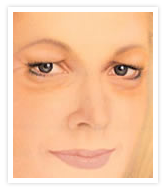
As people age, the eyelid skin stretches, muscles weaken, and fat accumulates around the eyes, causing "bags" above and below.
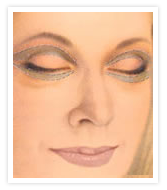
Years of squinting and other facial muscle movements can take their toll on the eye area, leaving crow's feet and other noticeable lines.
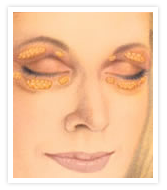
Before surgery, the surgeon marks the incision sites, following the natural lines and creases of the upper and lower eyelids.
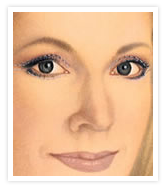
Underlying fat, along with excess skin and muscle, can be removed during the operation.
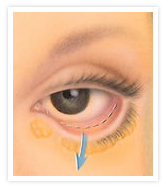
In a transconjunctival blepharoplasty, a tiny incision is made inside the lower eyelid and fat is removed with fine forceps. No skin is removed, and the incision is closed with dissolving sutures.
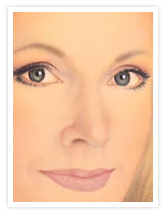
After surgery, the upper eyelids no longer droop and the skin under the eyes is smooth and firm.